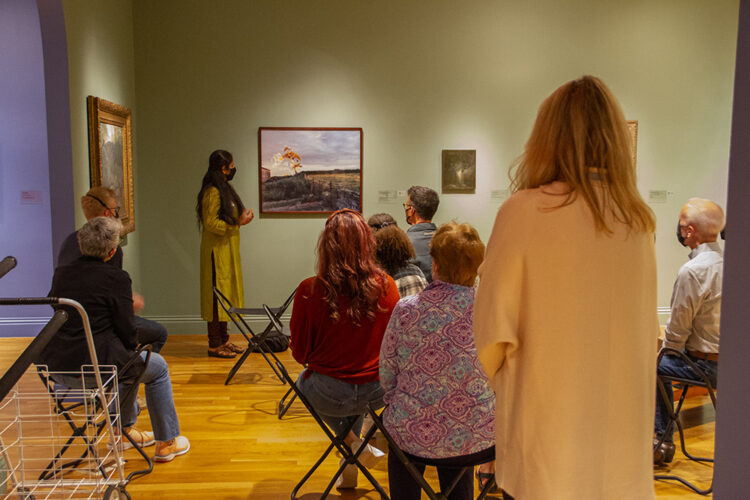Museum Educator Carla Freyvogel shares her experience at the first session of the NatureISpiritIArt workshop on art and climate change.
At the end of the day, it is all about relationships. Relationships to each other, relationships to our own best and worst selves, relationships to art . . . and relationships to nature.
We began the first session of NatureISpiritIArt by establishing our relationships to each other. Using the “Art Card Game” produced by The Phillip Collection as a starting point for conversation, we exchanged ideas, connecting images of artworks to our personal stories. There were landscapes that reminded us of home in California, abstracted images that evoked moods, and colors that stimulated memories.
Aparna Sadananda then led a meditation in front of Self Portrait as a Tree, 2000, by Sam Taylor-Johnson, bringing us in and out of our visual relationship with the photograph on one hand and the inner workings of our minds on the other.

Aparna Sadananda leads a meditation in the galleries
With Joshua Shannon and Robert Hardies, facilitators of the five-week course, we pondered the degree to which we could see the human hand at work in Self Portrait as Tree. We identified the man-made, geometric structure of the shed, the rough-hewn rails of the fencing, the cultivated field juxtaposed with a cluster of wild grasses, and the two-track of dirt, the result of repeated visits by a pickup truck. What really is the relationship of humans to the natural world? If we begin to examine art through an “eco-critical lens,” we focus in on the underlying messages about how humans relate to the natural world.
In a post-meditative calm, we roamed the gallery, looking beyond Self Portrait with Tree to the other landscapes on the wall. Practicing our “eco-critical lens” we see these in a new light. Might we be in a soft, accommodating space with nature, coexisting as in George Inness’s Moonlight, Tarpon Springs? Are we exploitative, as we parade down the ramp of a bridge meant for show, as in Julian Alden Weir’s The Fishing Party? Or do we treat nature as “other” as Augustus Vincent Tack’s Winter Landscape suggests—just a pretty picture of a vista that has nothing really to do with us?

Left to right: George Inness, Moonlight, Tarpon Springs, 1892; Julian Alden Weir, The Fishing Party, c. 1915; Augustus Vincent Tack, Winter Landscape, c. 1898-c. 1902
In his 1995 essay The Trouble with Wilderness, William Cronon suggests that “wilderness embodies a dualistic vision in which the human is entirely outside the natural. If we allow ourselves to believe that nature, to be true, must also be wild, then our very presence represents its fall …To the extent that we celebrate wilderness as the measure with which we judge civilization, we reproduce the dualism that sets humanity and nature at opposite poles.” In other words, no relationship.
But if we look back to Self Portrait with Tree, and think eco-critically, we can see that Sam Taylor-Johnson has shown us a tree leaning with the wind and the slope of the land, yet still reaching for the sky, saying, “Yes, some limbs might be broken, but the sunlight of this sky, the rain storm that may come, will nurture me as a person and me . . . as a tree.” A symbiotic and beautiful relationship.
I have a hint now of what is in store for us in this program. Our time together, with the goal of cultivating personal resilience in the face of climate change, will provide me another way to appreciate and find relevance in our collection.
